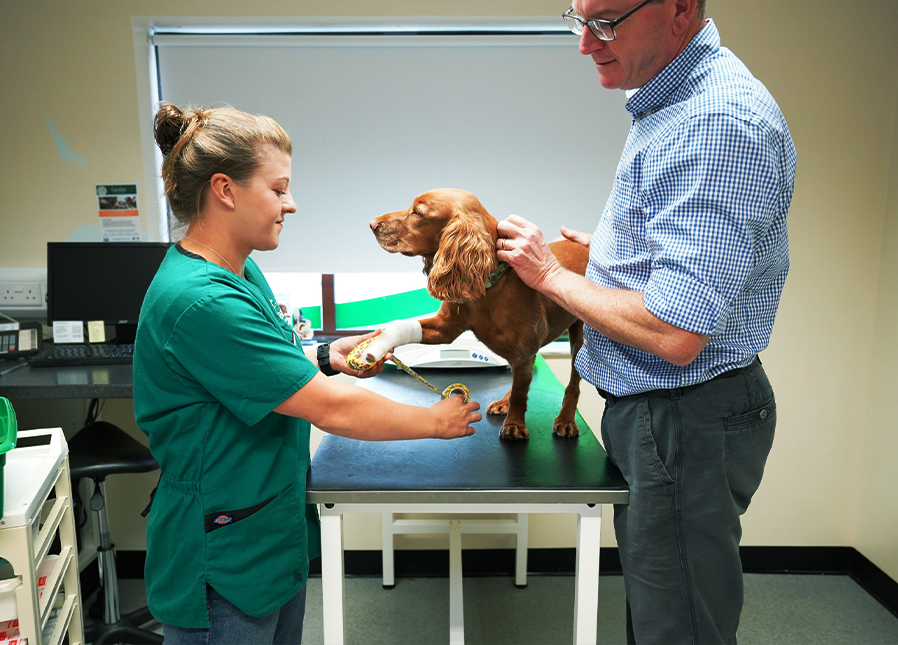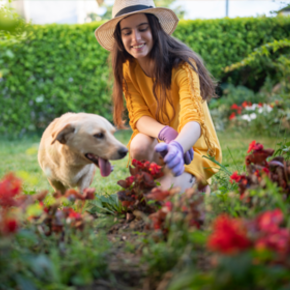
The sun is out, everything is in flower, and everyone has come out of hibernation: gardening season has begun! While this is a lovely time of year to spend with your pet, there are potentially poisonous plants in your garden that will affect cats and dogs. At Garston Vets, we can assist you with pet-proofing your garden by providing a list of common garden plants that are toxic to pets. Read on to learn more about common garden plants you need to look out for and the symptoms of plant poisoning.
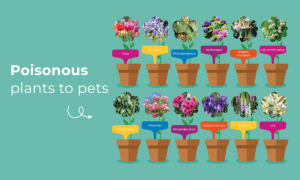
See below for 12 poisonous plants to look out for and the symptoms of poisoning in your cat or dog.
Hydrangea
Signs and symptoms of hydrangea poisoning:
- Vomiting
- Lethargy
- Diarrhoea.
If you suspect your dog has ingested any part of a hydrangea plant, it’s crucial to contact your vet immediately. The earlier treatment is initiated, the better the chances of a full recovery. Early intervention can involve inducing vomiting, administering activated charcoal to absorb toxins, and providing supportive care to manage symptoms and prevent complications.
Lilies
Signs and symptoms of lily poisoning:
- Vomiting
- Not eating.
- Drooling
- Drinking or peeing more
- Twitching, seizures or sudden death
Every part of the lily, including the pollen is very poisonous to cats. Seek veterinary advice immediately if you think your cat has come in contact with this plant. To prevent lily poisoning, it is recommended to remove cut lilies from flower arrangements in the home.
Contact us immediately if you notice any of the above behaviours after your pet has consumed lilies or has lily poisoning.
Lily of the valley
Lily of the valley is one of the most poisonous plants to cats and dogs. The plant’s bulb, roots, stems, leaves, blooms and berries are all poisonous.
Signs and symptoms of lily of the valley plant poisoning
- Diarrhoea
- Vomiting
- Blood in the stool
- Discomfort in the abdomen.
If you think your pet may have eaten any part of the lily of the valley plant, contact your nearest vet immediately.
Autumn Crocus
The autumn crocus is toxic in all parts, but particularly in the bulb, blooms and seeds. Autumn crocus contains tropane alkaloids, which are extremely poisonous to dogs and can cause serious renal issues or even organ failure.
Signs and symptoms of autumn crocus poisoning:
- Burning in the mouth
- Increased salivation
- Thirst
- Difficulty swallowing
- Stomach pain
- Diarrhoea
- Blood in urine or failure to pass urine.
Call us immediately if you believe your pet has swallowed an autumn crocus. Consider removing any of the remaining plant from your home or outdoor areas to prevent further exposure to your pet once your pet has received medical attention.
Oleander
Poisoning Symptoms after Oleander Consumption:
- Diarrhoea
- Elevated heart rate
- Drowsiness
- Seizures or lack of consciousness.
When dogs swallow oleanders, they need to be treated by a vet as soon as possible.
Rhododendron
These gorgeous blooming plants surround many homes; however, it’s very toxic to pets! All parts of the rhododendron plant are toxic for dogs. The rhododendron plant’s leaves are the most harmful, although the flowers and nectar can also be dangerous.
Signs and symptoms of Rhododendron Poisoning
- Gastrointestinal upset
- Weakness
- Paralysis
- Abnormal heart rhythms.
If your pet consumes large doses of this plant, it can be fatal. We advise that you seek veterinary care as soon as possible if you think your pet has consumed this plant.
Angel’s trumpets
Many people own this plant without realising how harmful it is to their pets since it produces beautiful blooms. While most pets are deterred from nibbling on the leaves by their strong odour, some creatures are not.
Signs and symptoms of poisoning include:
- Behavioural changes
- Disorientation
- Dilated pupils
- Hyperthermia
- Loss of appetite
- Change in heart rate
- Change in respiratory rate.
We advise immediate veterinary care if your pet has ingested this plant.
Bluebells
Bluebells are a spring favourite and is a common flower that you may find on woodland walks, in your garden and even on the sides of the road. Bluebells contain a toxin that affects the heart, and are poisonous to dogs.
Signs and symptoms of bluebell poisoning:
- Stomach pain
- Dermatitis and irritation of the skin
- Vomiting
- Diarrhoea
- Drooling
- Trembling
- Lethargy
- Reduced heart rate.
Foxgloves
All parts of the foxgloves plant are poisonous to dogs, cats, and even humans. These toxins, called cardiac glycoside toxins, affect the heart by disrupting its internal balance.
Signs and symptoms of foxglove poisoning:
- Nausea
- Tremors
- Collapse.
If you believe your dog has ingested or chewed a piece of this plant, treat it as a medical emergency and contact your vet as soon as possible. Foxglove poisoning lacks an antidote; thus, supportive therapy becomes the primary treatment approach.
Garden Hazards for Pets
To ensure that your pets don’t try to eat or nibble on your home plants while you’re away, it’s best to keep them out of reach. Additionally, keep an eye on your dog to make sure they haven’t discovered any plants that might endanger them when they’re on walks or in the garden. Keeping them on a lead would make this easier when walking them.
Plants that are Safe for Your Pets
Shrubs
- Black Hawthorn
- Chaparral
- Crimson Bottlebush
- Magnolia Bush
- Mulberry Bush
- Rose.
Trees
- Big shellbark hickory
- Bitter pecan
- Bottle palm
- Carob tree
- Figleaf palm
- Hemlock tree
- Iron tree
- Japanese aralia
- Mockernut hickory
- Mulberry tree
- Pupleosier willow
- Red maple
- Silver bell tree
- Tree cactus
- Tulip poplar.
Flowers
- African violet
- Bromeliads
- Creeping zinnia
- Gerbera daisy
- Lipstick plant
- Petunia
- Phalaenopsis orchid
- Zinnia
Houseplants
- American rubber plant (Common names: pepper face, baby rubber plant)
- Blue echeveria, a succulent (Common names: maroon chenille, painted lady, copper rose, wax rosette, plush plant, “hen and chicks”)
- Boston fern
- Cast iron plant
- Christmas cactus
- Donkey’s tail, a succulent
- Parlor palm
- Spider plant
- Swedish ivy.
Learn more about other dangers for your pet, with our blogs about chocolate poisoning here and our post on the dangers of conkers here for more information on things to keep out of your pet’s reach!

From skin irritations to digestive issues, understanding and addressing common allergies in dogs is essential for ensuring their wellbeing. In this blog, we delve into the world of canine allergies, exploring their types, symptoms and effective management strategies.
Food Allergies in Dogs
Food allergies can manifest through various symptoms, including gastrointestinal issues or skin problems. Common food allergens for dogs include proteins such as beef, chicken, dairy and grains like wheat and soy. Symptoms of food allergies in dogs may include itching, redness, swelling, ear infections, vomiting, diarrhoea or changes in bowel habits. It’s essential to distinguish between food allergies and food intolerances, as they may present similar symptoms but have different underlying mechanisms.
Your vet may recommend hypoallergenic or prescription diets that exclude the identified allergens. In some cases, they might also suggest the use of supplements like omega-3 fatty acids to promote skin health. It’s important for dog owners to adhere to the prescribed diet to effectively manage and alleviate food allergies. Speak to a vet at Garston for advice on the best food for your dog and what to avoid, as well as a proper diagnosis of food allergies.
Contact Allergies
Contact allergies in dogs, also known as contact dermatitis, occur when a dog’s skin reacts adversely to certain substances it comes into direct contact with. These substances, called allergens, can cause irritation and inflammation on the skin. Common sources of contact allergies in dogs include certain plants, chemicals, cleaning agents, fabrics and materials. Should your canine companion be allergic to certain materials, skin irritation and itching will manifest at the sites of contact, often the feet and stomach. When the allergen is identified and removed, the issue is often resolved, however systemic or topical therapies could be necessary. Allergies caused by contact could be more common in certain seasons of the year, impacted by your pet’s environment. Pollen, dust and certain plants can cause irritation.
If you suspect your dog has contact allergies, it is advisable to consult with a nurse or vet for a check-up to discuss this, which may lead to a tailored treatment plan. Additionally, preventive measures such as avoiding known allergens and using hypoallergenic products can help manage and reduce the likelihood of contact allergies in dogs.
Book an allergy appointment with us.
Flea Allergies
An insect bite allergy is an intensified inflammatory reaction to the bite or sting of an insect. Sensitive dogs may experience this allergic response from arachnids like spiders and ticks, as well as insects such as fleas, blackflies, deerflies, horseflies, mosquitoes, ants, bees, hornets, and wasps. The most prevalent insect allergen in dogs that causes flea allergy dermatitis (FAD) is flea saliva. Flea bites cause modest local irritation in most dogs. A single bite will cause local itching. Consulting with a nurse at Garston Vets can offer guidance on safeguarding your dog and other pets against fleas.
In situations where rigorous flea control is challenging or when dealing with intense itching, your vet might recommend antihistamines or corticosteroids (steroids) to mitigate the acute allergic reaction and provide immediate relief.
Learn more about flea and worming treatment for your dog.
Diagnosing Allergies in Dogs
Diagnosing flea allergy dermatitis is typically straightforward. The identification of fleas on your dog’s body and the application of a flea-killing product to prevent bites are commonly used for diagnosis. It is also important that environmental control of fleas is done during this time to help reduce the ongoing flea infestation.
If allergies are suspected, your vet may suggest specific tests to identify the allergen responsible for the reaction. It’s important to note that determining the exact cause of an allergy through testing may not always be feasible.
Treating Allergies in Dogs
The optimal approach to managing an allergy involves avoiding the trigger and allergen, though this may not always be feasible. The specific treatment method varies based on the type of allergy affecting your dog. For instance, addressing flea allergy dermatitis entails eliminating the fleas, while managing a food allergy or intolerance necessitates a dietary change.
We will recommend different treatments depending on the cause and severity of your dog’s allergic reaction. For hives, antihistamines, cortisones or medicated shampoos may be recommended. In the case of food allergies, suggestions might include incorporating fish oil or other Omega-3 fatty acid supplements. Skin allergies may be addressed with vet-prescribed anti-inflammatory wipes or soothing shampoo to alleviate irritation.
Depending on the cause and severity of your dog’s allergic reaction, we will examine your pet and recommend the best treatment plan for them. In addition to any lifestyle changes that might be necessary, we may also prescribe an allergy relief medication for your dog that will help control the signs associated with the allergic reaction, such as itching and any secondary skin infections that might have developed as a result of the irritant.
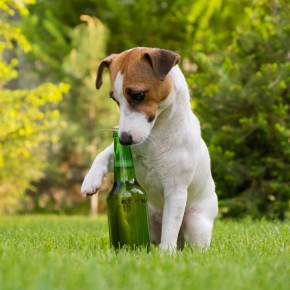
As the days grow longer and the temperatures rise, many dog owners in Wiltshire and Somerset find themselves drawn to the outdoors, eager to spruce up their gardens and enjoy the beauty of spring. While gardening can be a delightful activity, it’s crucial to consider the safety of our furry companions, especially our inquisitive dogs.
Garston Vets have some essential spring garden safety tips to ensure a hazard-free environment for your canine companion. Remember, if you ever encounter an emergency, don’t hesitate to call our vet practice immediately on 01373 452225.
See all our contact information
What to watch out for in your garden
- Pet-Friendly Plants: Spring often brings an array of blooming plants, but not all of them are safe for our canine friends. Some common garden plants, such as azaleas, tulips, and daffodils, can be toxic to dogs if ingested. Research the plants in your garden and remove any that may pose a risk. Garston Vets’ advice is to choose pet-friendly alternatives like marigolds, sunflowers, or snapdragons to add colour without risking your dog’s health.
- Fertilisers and Mulch: As you prepare your garden for the growing season, be cautious with fertilisers and mulch. Many commercial fertilisers contain chemicals that can be harmful if ingested by dogs. Choose pet-safe fertilisers and mulch options to minimise the risk. Additionally, keep your dog away from freshly treated areas until the products have been absorbed or watered in to prevent accidental ingestion.
- Pesticides and Herbicides: While pests and weeds may pose challenges in the garden, the use of pesticides and herbicides requires careful consideration. These chemicals can be toxic to dogs, both through direct contact and ingestion. Our team recommends opting for pet-safe alternatives or natural pest control methods to protect your garden without compromising your dog’s well-being. If you must use chemical products, ensure they are thoroughly dry or absorbed before allowing your dog access to the treated areas.
- Secure Fencing: Spring is a time when many dogs in Wiltshire and Somerset will become more active outdoors and eager to explore. Ensure that your garden is securely fenced to prevent your dog from wandering off or encountering potential dangers beyond your property. Regularly inspect the fence for any gaps or damage that may compromise its integrity. A secure fence not only keeps your dog safe but also provides them with a designated space to enjoy the outdoors.
- Watch Out for Sharp Objects: As you engage in gardening activities, be mindful of sharp tools and objects that may pose a risk to your dog’s paws or mouth. Store gardening tools safely and keep them out of your dog’s reach. Check the garden for any stray nails, broken glass, or sharp objects that could cause injuries. A tidy and well-maintained garden ensures a safer environment for your curious canine companion.
Spring is a wonderful time to cultivate a beautiful and pet-friendly garden. By following Garston Vets’ spring garden safety tips, you can create a space where your inquisitive dog can enjoy the outdoors without encountering potential hazards. Remember, your pet’s safety is our top priority. If you ever find yourself in an emergency situation, don’t hesitate to call our vet practice immediately on 01373 452225.
Go on, share our article and these tips with your friends & family and help us ensure a happy and healthy springtime for dogs in Wiltshire and Somerset and beyond!
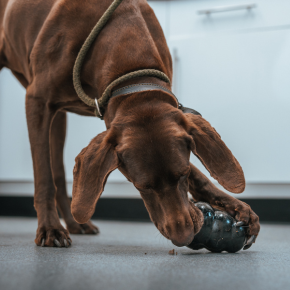
As winter coats the roads with ice, you will often see the flashing orange lights of salt spreaders out and about to make the roads safe. You will also likely see salt being spread on pavements and car parks for the same reason, however, some of it can be difficult to spot.
While this solution is effective for human safety, it poses a hidden danger to our four-legged friends. Road salt, or rock salt, may keep roads and pavements clear and preventing slipping, but its impact on dogs can be quite hazardous.
Contact Garston Veterinary Group on 01373 452225 if you have any concerns about your dog’s health.
What is road salt?
Road salt is typically composed of sodium chloride, calcium chloride, or magnesium chloride. It is used to lower the freezing point of water. When sprinkled on icy roads and paths, it prevents the formation of ice and helps make surfaces safer for vehicles and walkers.
The dangers of road salt for dogs
Paw irritation & dehydration
The most immediate risk for dogs is the irritation road salt can cause to their paws. When dogs walk on salted surfaces, their paw pads can become cracked, dry, and painful. This can lead to discomfort, limping, and difficulty walking.
Road salt is a desiccant, which means it can absorb moisture from a dog’s paws and skin. Extended contact with road salt can lead to dehydration and skin issues.
Oral ingestion
Dogs are known for their inquisitive nature and may lick or chew their paws after walking on salted surfaces. In doing so, they can ingest road salt, which is toxic to dogs when consumed in significant quantities causing:
a) Digestive issues
Ingesting road salt can lead to gastrointestinal upset in dogs. Symptoms may include vomiting, diarrhoea, drooling, and abdominal pain.
b) Salt toxicity
Andy stresses that the most severe risk is salt toxicity, which can occur if a dog consumes a large amount of road salt. This can lead to symptoms such as excessive thirst, tremors, seizures, and, in severe cases, even death.
How to prevent road salt related issues
- Protective Paw Balm: Andy suggests considering using a paw balm or wax to create a protective barrier on your dog’s paw pads before going outside.
- Booties: Dog booties provide excellent protection from road salt, keeping paws dry and safe.
- Avoid Salted Areas: Whenever possible, avoid walking your dog on salted surfaces. Choose areas with minimal salt use.
- Wipe Paws: After walks, wipe your dog’s paws with a damp cloth to remove salt and prevent ingestion.
- Indoor Rinsing: Rinse your dog’s paws with warm water when returning home to remove salt residue.
- Pet-Friendly Salt: If you need to use salt on your property, choose pet-friendly, non-toxic alternatives.
- Supervision: Always supervise your dog when they’re outside, especially around areas treated with road salt.
In conclusion, road salt is essential for human safety during winter, but it poses several risks to dogs. By taking proactive measures to protect your dog’s paws and avoid salted areas, you can ensure their safety and wellbeing during the winter months. Our team recommend that a little extra care can go a long way in keeping your furry companion healthy and happy.
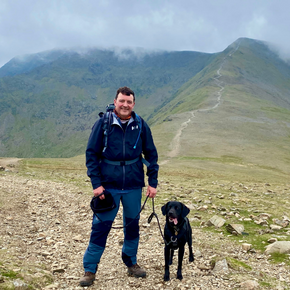
Are you planning on starting 2024 with a holiday? If so, good on you! If you plan to take your dog with you, then read on for our top tips on how to plan for your holiday.
Not taking your dog on holiday with you? No problem – download our list of questions to ask kennels whilst you research your dog’s temporary accommodation.
Download our kennel research guide
Deciding on your destination
You need to make sure your chosen destination and accommodation have plenty of dog-friendly spaces and activities to keep them happy. Popular staycation holiday choices in the UK are log cabins or pet-friendly cottages. Some areas will only allow dogs on the beach during certain months so researching ahead will help you plan your holiday. This research can also help you work out whether your dog could need extra training or socialisation ahead of your trip.
Transport options
If you are planning on travelling abroad, it is essential that you start planning your pet’s travel arrangements as early as possible. There will be animal health certificates and often vaccines and other health checks that need to be completed ahead of your holiday. These will be affected by time limits – learn more about pet travel.
If you are planning a staycation in the UK, make sure your chosen transport is suitable for your dog and the holiday you’ve chosen. More remote destinations will need car transport, which could be an issue if your dog becomes car sick. Trains and ferries may be a necessary part of the journey to your holiday destination – how would your dog cope with these?
Protect your pet
Before you leave for your holiday, ensure you have researched local vets near your destination just in case your dog requires veterinary treatment whilst away. You also need to make sure your pet’s microchip and collar ID tag have the most up-to-date contact details recorded. If you become separated whilst away, it is essential that a veterinary professional/animal shelter can get hold of you.
If you are holidaying abroad, keep your dog’s vaccine certificates, clinical history, and their animal health certificates to hand. To request a copy of your dog’s clinical history, contact our reception team.
It’s also worth checking that your pet insurance policy covers your dog for unexpected veterinary expenses, in case emergency veterinary treatment is needed, also if going abroad.
Essentials to pack for your dog
Remember to pack your dog’s food, treats, feed/water bowls, medication, collar, lead and harness, toys, bedding, grooming equipment, shampoo (For the dogs who like to get muddy) and poo bags. Their bed and blankets will help them feel comfortable and secure in their new surroundings.Did you know that you can also buy PitPat GPS trackers, which has coverage across the UK and some other countries.
By carefully planning and preparing for your early bird holiday with your dog, you’ll be able to create wonderful memories together while ensuring their safety, health, and happiness throughout the trip. Contact us on 01373 452225 if you have any questions about taking your dog on holiday and need some veterinary advice.
Alternatively, if you’re not taking your pet on holiday with you,

Seasonal surgery opening hoursChristmas Eve 24th December – Emergency team Christmas Day 25th December – Emergency team Boxing Day 26th December – Emergency team Wednesday 27th December – Normal opening hours Thursday 28th December – Normal opening hours Friday 29th December – Normal opening hours Saturday 30th December – Normal opening hours New Year’s Eve 31st December – Emergency team New Year’s Day 1st January – Emergency team Tuesday 2nd January – Normal opening hours Please remember to place food and repeat prescription orders by Wednesday 20th December 2023 Emergency CareAs a client of Garston Vets, you can feel confident that we are always available to deal with any pet emergency that may arise, day or night, including Christmas Day, Boxing Day and New Year’s Day. We are one of the few practices in Somerset & Wiltshire that operate our own out of hours emergency service on-site at our accredited small animal hospital at Garston House in Frome. Our hospital is staffed 24 hours a day, 7 days a week, looking after sick and injured patients or those requiring post-operative observational care – your pets are never left alone. It is the same cohesive team of vets and nurses that look after your animals out-of-hours as you will meet during the day at any of our practices. Our computerised patient records from all our surgeries are securely linked via internet servers, so we have access to all your pets’ clinical records whatever time of the day. If you have a pet emergency, please call us on 01373 452225 |
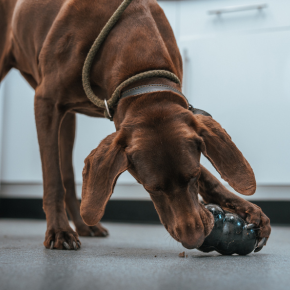
Ou nurse, Natalie, believes that it is never too early for pet owners to start preparing for the upcoming firework season. The bright lights and loud noises of fireworks can cause dogs and cats an unprecedented amount of stress. To minimise stress levels and to reduce the risk of injuring themselves during firework season, we recommend that you book an appointment to discuss what options are available to help.
Contact us about calming products in advance
There are many products available to help keep your household calm during firework season, however, as each animal is unique, so it is important to find out what will suit them best. Examples of these are:
- Calming supplements – These promote relaxation and come in various forms, such as dog chews, tablets and liquids. They tend to use ingredients thought to contain calming properties such as chamomile, valerian root and L-theanine.
- Thunder shirts – A vest that provides constant but gentle pressure to your dog’s body. This will have a calming effect, similar to a baby being swaddled.
- Pheromone diffusers – These release synthetic, man-made pheromones mimicking the natural calming pheromones released by dogs. These diffusers will help to reduce their anxiety levels during firework season.
- Prescription medication – There are a number of different medications that could be prescribed by our team. Anti-anxiety medication can medically help to reduce your dog’s anxiety by reducing the serotonin levels in their brain. There are either long-acting or short-acting options available and both will need to be dispensed and their dosage prescribed by a vet who has examined your pet.
As well as the products above, there are a number of different management techniques you can try at home to make firework season a little less stressful for everyone:
- Walk your dog during daylight hours and make sure they are snuggled up indoors when it goes dark.
- Create a safe space for your pet to hide when they’re feeling anxious. This could be a quiet corner of a room, away from a window and its essential they feel like they’re in control in this area. Once they take themselves to that area, do not interfere with your pet while they are in their safe space.
- Use their favourite toys/bedding/treats in this area so they start to associate positively with it and ensure they have access to it at all times.
- Muffle the sound of fireworks by shutting windows and black out the light flashes by drawing the curtains/blinds.
- Putting on the television or playing music in the background will help distract your dog – Classic FM’s pet classics is a hit for pets across the country, learn more about this here.
There are a number of different ways that owners can help their dogs during firework season, but our team of experienced vets can also advise and help when needed. Book an appointment with us at least 6 weeks before any planned events to give your pet the best chance at a calm firework season. Don’t forget that the consultation fee is included in our NEW Premium Wellness Plan membership.
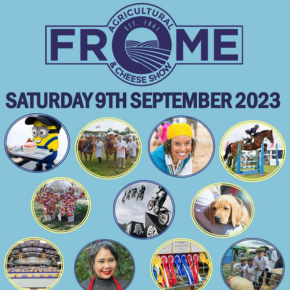
We are back at Frome Agricultural & Cheese Show for our 17th year. As always, our trade stand is situated opposite the dog show ring, you honestly can’t miss us!
Our tea and cake bar has become a firm favourite with show visitors and this year you can choose from raspberry & white chocolate muffins, fruit and nut flapjack, bread pudding and gingerbread biscuits to accompany your hot drink. Why not try our popular Garston travel mug deal and enjoy unlimited refills of tea, coffee or orange juice all day?
We also have a great selection of pet merchandise to purchase, along with our NEW harvest festival themed dog shop and tombola.
Fresh water and treats are available all day for our four-legged visitors, plus there’s always a vet on call should you need us in an emergency.
The Garston Dog Ring schedule will keep the crowds entertained all day, with lots of demonstrations and fun show classes from 9.30am – 5pm thanks to Charismatic Pets and M&M Gundogs.
Dog show class registrations start at 9am at our trade stand on show day. Each entry is £3.00, and every entrant receives a rosette with a prize for 1st place.
9.30-10.30am: Come and meet the behaviourist.
Come along and ask the behaviourist any questions you have relating to dog behaviour.
10.30-11am: Scent work demonstration
Pet dogs can do scent work too. Come and watch a searching demo to see how it’s done.
11-11.30am: M & M Gundog scurry demonstration
Watch Martin’s dogs find and retrieve a dummy in record time.
11.30-12pm: Most charismatic puppy (under 1 year)
Enter your gorgeous puppies. Any breed welcome must be under 1 year of age.
12-12.30pm: Most handsome gentleman (over 1 year)
Enter your handsome lads. Any age and breed welcome.
12.30-1pm: Prettiest lady (over 1 year)
Enter your prettiest girls. Any age and breed welcome.
1-1.30pm: ‘Have a go’ Hoopers and demonstration
Watch how Hoopers works with our demo and then have a go yourselves on a Hoopers course. Any age and breed welcome.
1.30-2pm: Dog Parkour demonstration
Feet on, feet in, unders, throughs and more. Come and see our parkour pups having fun!
2-2.30pm: M & M Gundog scurry demonstration
Watch Martin’s dogs find and retrieve a dummy in record time.
2.30-3pm: Most charismatic puppy (under 1 year)
Enter your gorgeous puppies. Any breed welcome must be under 1 year of age.
3-3.30pm: Most handsome gentleman (over 1 year)
Enter your handsome lads. Any age and breed welcome.
3.30-4pm: Prettiest lady (over 1 year)
Enter your prettiest girls. Any age and breed welcome.
4-5pm: ‘Have a go’ lure chase
Let your pooch have a go at chasing the lure around the luring course. The faster the better! Must be over 1 year. All breeds welcome.
All money raised will be donated to Move the Mind
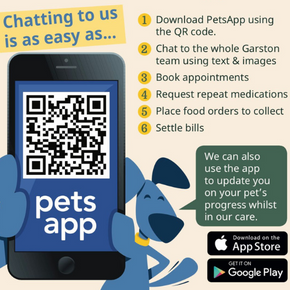
Chatting to our small animal team, booking appointments, requesting repeat medication and food orders, plus settling bills and keeping up to date with your pet’s progress while staying with us has just got a great deal easier.
PetsApp is our new online service that is keeping our phone lines free for more urgent calls. If you haven’t downloaded PetsApp already, you can do so:
By responding to our SMS invitations,
or
By clicking on the magic link https://petsapp.com/ml/ubgjLa2c2n9i3BEi9, selecting your usual Garston surgery, and creating your pet’s profile,
or
By using the PetsApp chat tab on our website in the bottom right-hand corner of our homepage.
Once you have a PetsApp account the whole family can use the same log-in to contact us about your pet.
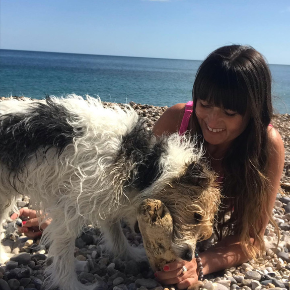
Our nurse, Gemma understands how exciting it can be taking your furry friend on a UK holiday. However, it’s important to keep in mind that dogs have specific needs and require proper care and attention to stay safe this summer. Gemma has put together some essential tips to help you keep your dog happy whilst on holiday in the UK.
We’ve also got an invaluable guide on how to improve your dog’s travel sickness woes here:
Download our holiday travel sickness guide
Dog Friendly Holiday Checklist
Pack essentials
When packing for your UK holiday, make sure to pack your dog’s essentials. This includes food, water, treats, and any medication your dog requires. You should also bring a lead, poo bags, and their favourite toys to keep them entertained.
Research dog-friendly accommodations
Before booking your accommodation, research what dog-friendly options are available. Many hotels, cottages and campsites in the UK are dog-friendly, but it’s important to check the rules and regulations beforehand. Some accommodations may have restrictions on the size or breed of the dog, while others may charge an additional fee. Ask friends and family what dog-friendly accommodation they know of and our team of animal lovers may also have some recommendations!
Exercise regularly
Dogs require regular exercise to stay healthy and happy. When on a UK holiday, make sure to take your dog for daily walks or runs to keep them active. You can also explore dog-friendly beaches or parks to give your dog more space to run and play. Head Vet Andy also recommends, depending on the length of your commute, stopping to let your dog stretch their legs and go to the toilet. Going on a UK holiday is usually a much longer journey than what your pet is used to so breaking it up can help keep them comfortable whilst travelling.
Provide adequate rest
While it’s essential to keep your dog active, it’s equally important to provide adequate rest. Dogs require proper sleep to stay healthy and happy, so make sure to provide them with a comfortable place to sleep. Andy recommends taking familiar blankets and if you can squeeze it in, take their usual bed to make sure your dog is comfortable for the duration of your stay.
Keep them hydrated
Make sure your dog has access to clean and fresh water at all times. This is especially important during hot weather, as dogs can become dehydrated quickly. Carry a water bottle and portable bowl with you when out and about to ensure your dog stays hydrated. Andy also wants owners to remember to not walk their dogs during the hottest part of the day on Summer holidays.
Follow local rules and regulations
When on a UK holiday with your dog, it’s important to follow local rules and regulations. Many public places such as beaches and parks have specific rules for dogs, such as requiring them to be on a lead, only allowing them access during certain months or limiting the number of dogs per person.
In conclusion, keeping your dog healthy and happy on a UK holiday requires proper planning and preparation. With these tips, you can ensure that your furry friend has a happy and healthy holiday alongside you. If you know somebody who is planning a UK holiday with their dog, share this article with them.
Don’t forget to download our travel sickness guide for dogs to ensure your staycation commute goes smoothly for both you and your pet!


